IT Infrastructure Report: ANZ Bank's IT Systems and Processes
VerifiedAdded on 2021/04/17
|15
|3072
|291
Report
AI Summary
This report provides a comprehensive overview of the IT infrastructure utilized by the Australia and New Zealand Banking Group (ANZ). It examines the various services offered by ANZ and how different departments leverage IT to facilitate their operations, including HR, IT and testing departments. The report delves into the types of data structures employed and the IT infrastructure supporting them, such as replication of systems and data centers, along with the utilization of application server farms and standby data servers. It further details the operating systems and application software essential for data communication within ANZ, including the role of encryption and security measures. The report also dissects the functions of each layer within the internet model, explaining how messages are delivered between layers during email transmission. Finally, it outlines the types of networks used by ANZ, providing a holistic view of the bank's IT ecosystem.

Running head: IT INFRASTRUCTURE
IT Infrastructure
[Name of the Student]
[Name of the University]
[Author note]
IT Infrastructure
[Name of the Student]
[Name of the University]
[Author note]
Paraphrase This Document
Need a fresh take? Get an instant paraphrase of this document with our AI Paraphraser

1IT INFRASTRUCTURE
Table of Contents
Introduction:....................................................................................................................................2
Discussion:.......................................................................................................................................2
Service provided by the organization, how each department uses the IT:..................................2
Types of data structures and the usage of IT infrastructure:.......................................................3
Operating systems and application software required for data communication..........................4
The function of each layer of the Internet model........................................................................6
Delivery of messages between the layers when an employee sends an email:..........................10
Kind of networks used at the organization................................................................................11
References:....................................................................................................................................13
Table of Contents
Introduction:....................................................................................................................................2
Discussion:.......................................................................................................................................2
Service provided by the organization, how each department uses the IT:..................................2
Types of data structures and the usage of IT infrastructure:.......................................................3
Operating systems and application software required for data communication..........................4
The function of each layer of the Internet model........................................................................6
Delivery of messages between the layers when an employee sends an email:..........................10
Kind of networks used at the organization................................................................................11
References:....................................................................................................................................13
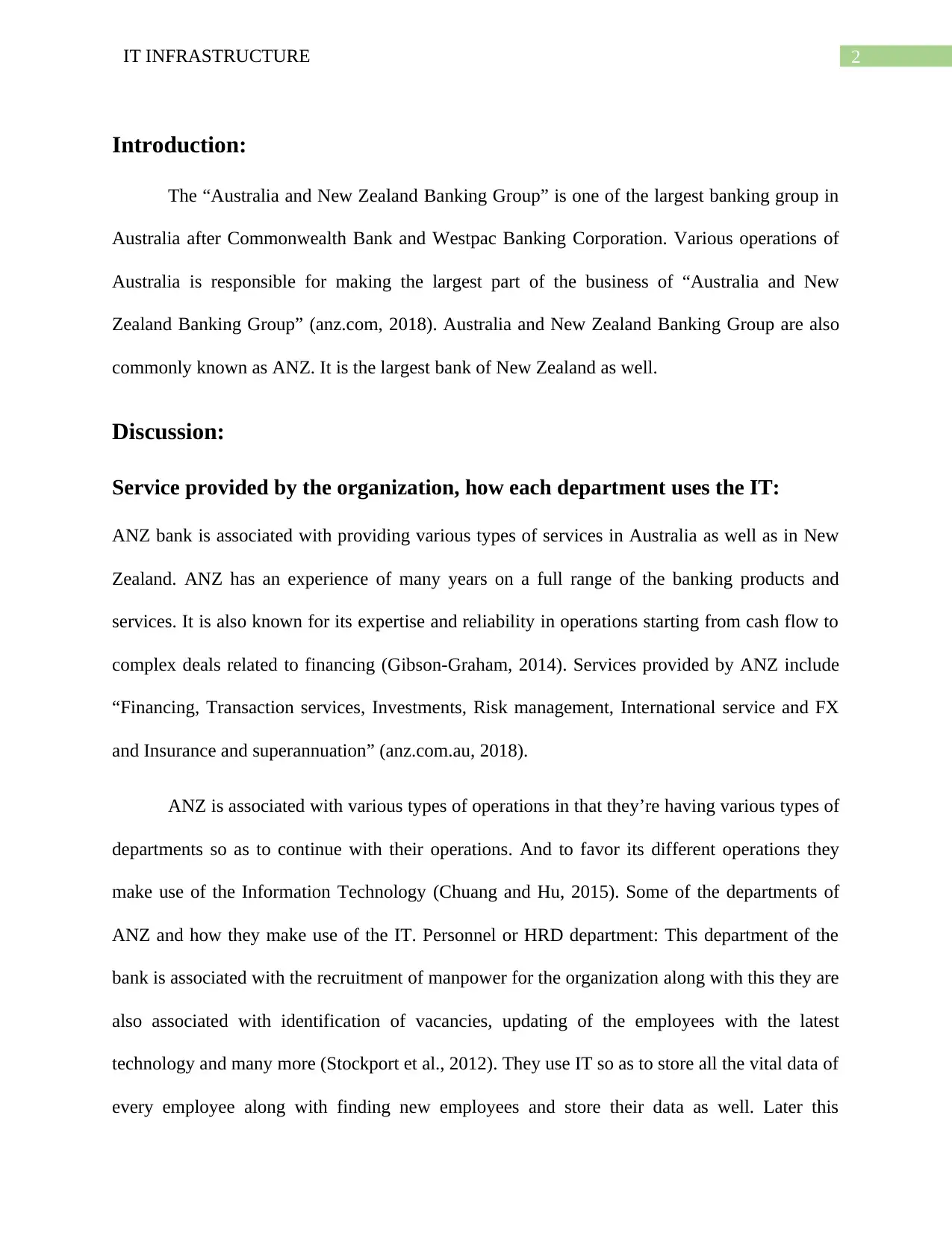
2IT INFRASTRUCTURE
Introduction:
The “Australia and New Zealand Banking Group” is one of the largest banking group in
Australia after Commonwealth Bank and Westpac Banking Corporation. Various operations of
Australia is responsible for making the largest part of the business of “Australia and New
Zealand Banking Group” (anz.com, 2018). Australia and New Zealand Banking Group are also
commonly known as ANZ. It is the largest bank of New Zealand as well.
Discussion:
Service provided by the organization, how each department uses the IT:
ANZ bank is associated with providing various types of services in Australia as well as in New
Zealand. ANZ has an experience of many years on a full range of the banking products and
services. It is also known for its expertise and reliability in operations starting from cash flow to
complex deals related to financing (Gibson-Graham, 2014). Services provided by ANZ include
“Financing, Transaction services, Investments, Risk management, International service and FX
and Insurance and superannuation” (anz.com.au, 2018).
ANZ is associated with various types of operations in that they’re having various types of
departments so as to continue with their operations. And to favor its different operations they
make use of the Information Technology (Chuang and Hu, 2015). Some of the departments of
ANZ and how they make use of the IT. Personnel or HRD department: This department of the
bank is associated with the recruitment of manpower for the organization along with this they are
also associated with identification of vacancies, updating of the employees with the latest
technology and many more (Stockport et al., 2012). They use IT so as to store all the vital data of
every employee along with finding new employees and store their data as well. Later this
Introduction:
The “Australia and New Zealand Banking Group” is one of the largest banking group in
Australia after Commonwealth Bank and Westpac Banking Corporation. Various operations of
Australia is responsible for making the largest part of the business of “Australia and New
Zealand Banking Group” (anz.com, 2018). Australia and New Zealand Banking Group are also
commonly known as ANZ. It is the largest bank of New Zealand as well.
Discussion:
Service provided by the organization, how each department uses the IT:
ANZ bank is associated with providing various types of services in Australia as well as in New
Zealand. ANZ has an experience of many years on a full range of the banking products and
services. It is also known for its expertise and reliability in operations starting from cash flow to
complex deals related to financing (Gibson-Graham, 2014). Services provided by ANZ include
“Financing, Transaction services, Investments, Risk management, International service and FX
and Insurance and superannuation” (anz.com.au, 2018).
ANZ is associated with various types of operations in that they’re having various types of
departments so as to continue with their operations. And to favor its different operations they
make use of the Information Technology (Chuang and Hu, 2015). Some of the departments of
ANZ and how they make use of the IT. Personnel or HRD department: This department of the
bank is associated with the recruitment of manpower for the organization along with this they are
also associated with identification of vacancies, updating of the employees with the latest
technology and many more (Stockport et al., 2012). They use IT so as to store all the vital data of
every employee along with finding new employees and store their data as well. Later this
⊘ This is a preview!⊘
Do you want full access?
Subscribe today to unlock all pages.

Trusted by 1+ million students worldwide

3IT INFRASTRUCTURE
information stored can be used for various purposes.IT and testing department: There exist
several technical types of equipment so as to check all the networks along with the various
devices that are being used by the bank employees so as to perform their daily tasks. Along with
there are also other departments that make of the IT infrastructure so as to perform the various
works.
Types of data structures and the usage of IT infrastructure:
The following data structure and IT infrastructure are used by ANZ for achieving success:
Replication of the all the systems and the client data between the primary as well as the
secondary data centers.
Backup on a daily basis
Application server farm needs to have a provision which Is responsible for the hosting of
all the Transactive (Nidar & Bestari, 2012). Which is to be distributed over all the
primary and the secondary data centers.
Providing provision over the standby channel data server present at all the secondary data
centers.
Providing provision over the components of standby core banking system which is
present at all the secondary data centers.
The provision of the secondary locations for bank staffs who are responsible for
supporting the ANZ Transactive channels.
The business continuity planning is reduced from the client-side by using ANZ
Transactive the web-based nature of ANZ Transactive where the system and much of the
data for critical business is held in the Bankside (Lee, Lim & Lim, 2013). Consequently,
for most of the part, there is only a need from the client side that they have an access to a
information stored can be used for various purposes.IT and testing department: There exist
several technical types of equipment so as to check all the networks along with the various
devices that are being used by the bank employees so as to perform their daily tasks. Along with
there are also other departments that make of the IT infrastructure so as to perform the various
works.
Types of data structures and the usage of IT infrastructure:
The following data structure and IT infrastructure are used by ANZ for achieving success:
Replication of the all the systems and the client data between the primary as well as the
secondary data centers.
Backup on a daily basis
Application server farm needs to have a provision which Is responsible for the hosting of
all the Transactive (Nidar & Bestari, 2012). Which is to be distributed over all the
primary and the secondary data centers.
Providing provision over the standby channel data server present at all the secondary data
centers.
Providing provision over the components of standby core banking system which is
present at all the secondary data centers.
The provision of the secondary locations for bank staffs who are responsible for
supporting the ANZ Transactive channels.
The business continuity planning is reduced from the client-side by using ANZ
Transactive the web-based nature of ANZ Transactive where the system and much of the
data for critical business is held in the Bankside (Lee, Lim & Lim, 2013). Consequently,
for most of the part, there is only a need from the client side that they have an access to a
Paraphrase This Document
Need a fresh take? Get an instant paraphrase of this document with our AI Paraphraser
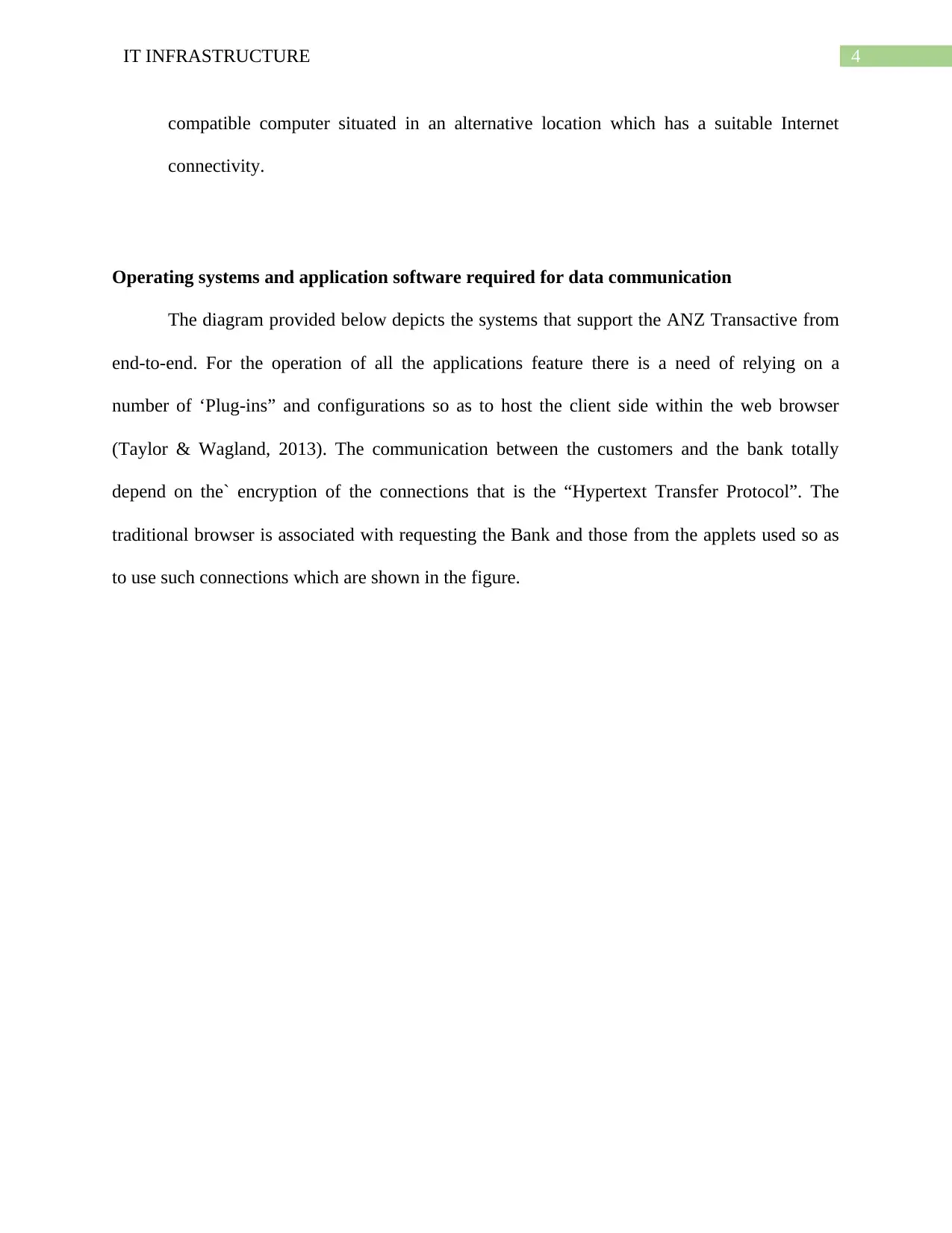
4IT INFRASTRUCTURE
compatible computer situated in an alternative location which has a suitable Internet
connectivity.
Operating systems and application software required for data communication
The diagram provided below depicts the systems that support the ANZ Transactive from
end-to-end. For the operation of all the applications feature there is a need of relying on a
number of ‘Plug-ins” and configurations so as to host the client side within the web browser
(Taylor & Wagland, 2013). The communication between the customers and the bank totally
depend on the` encryption of the connections that is the “Hypertext Transfer Protocol”. The
traditional browser is associated with requesting the Bank and those from the applets used so as
to use such connections which are shown in the figure.
compatible computer situated in an alternative location which has a suitable Internet
connectivity.
Operating systems and application software required for data communication
The diagram provided below depicts the systems that support the ANZ Transactive from
end-to-end. For the operation of all the applications feature there is a need of relying on a
number of ‘Plug-ins” and configurations so as to host the client side within the web browser
(Taylor & Wagland, 2013). The communication between the customers and the bank totally
depend on the` encryption of the connections that is the “Hypertext Transfer Protocol”. The
traditional browser is associated with requesting the Bank and those from the applets used so as
to use such connections which are shown in the figure.
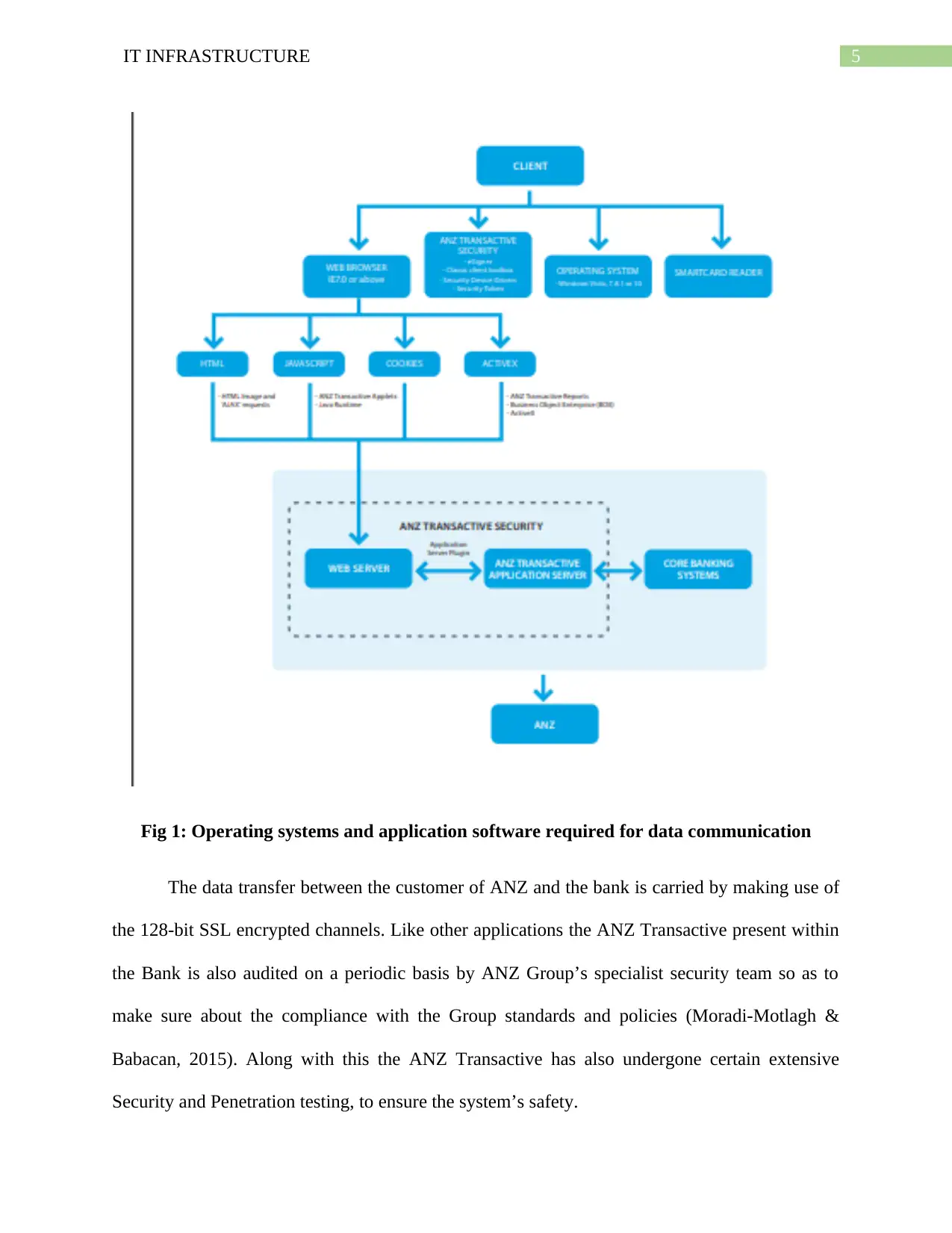
5IT INFRASTRUCTURE
Fig 1: Operating systems and application software required for data communication
The data transfer between the customer of ANZ and the bank is carried by making use of
the 128-bit SSL encrypted channels. Like other applications the ANZ Transactive present within
the Bank is also audited on a periodic basis by ANZ Group’s specialist security team so as to
make sure about the compliance with the Group standards and policies (Moradi-Motlagh &
Babacan, 2015). Along with this the ANZ Transactive has also undergone certain extensive
Security and Penetration testing, to ensure the system’s safety.
Fig 1: Operating systems and application software required for data communication
The data transfer between the customer of ANZ and the bank is carried by making use of
the 128-bit SSL encrypted channels. Like other applications the ANZ Transactive present within
the Bank is also audited on a periodic basis by ANZ Group’s specialist security team so as to
make sure about the compliance with the Group standards and policies (Moradi-Motlagh &
Babacan, 2015). Along with this the ANZ Transactive has also undergone certain extensive
Security and Penetration testing, to ensure the system’s safety.
⊘ This is a preview!⊘
Do you want full access?
Subscribe today to unlock all pages.

Trusted by 1+ million students worldwide
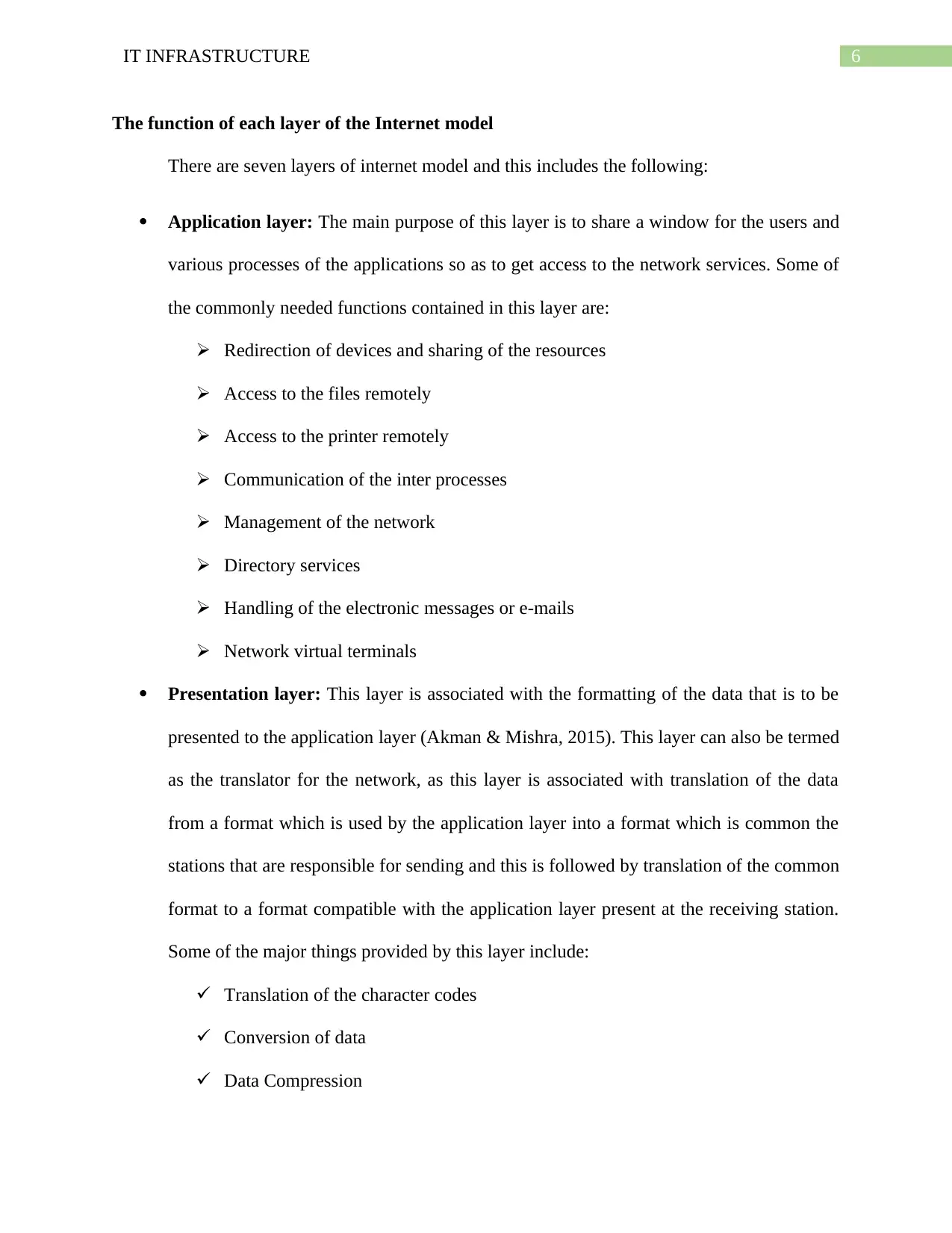
6IT INFRASTRUCTURE
The function of each layer of the Internet model
There are seven layers of internet model and this includes the following:
Application layer: The main purpose of this layer is to share a window for the users and
various processes of the applications so as to get access to the network services. Some of
the commonly needed functions contained in this layer are:
Redirection of devices and sharing of the resources
Access to the files remotely
Access to the printer remotely
Communication of the inter processes
Management of the network
Directory services
Handling of the electronic messages or e-mails
Network virtual terminals
Presentation layer: This layer is associated with the formatting of the data that is to be
presented to the application layer (Akman & Mishra, 2015). This layer can also be termed
as the translator for the network, as this layer is associated with translation of the data
from a format which is used by the application layer into a format which is common the
stations that are responsible for sending and this is followed by translation of the common
format to a format compatible with the application layer present at the receiving station.
Some of the major things provided by this layer include:
Translation of the character codes
Conversion of data
Data Compression
The function of each layer of the Internet model
There are seven layers of internet model and this includes the following:
Application layer: The main purpose of this layer is to share a window for the users and
various processes of the applications so as to get access to the network services. Some of
the commonly needed functions contained in this layer are:
Redirection of devices and sharing of the resources
Access to the files remotely
Access to the printer remotely
Communication of the inter processes
Management of the network
Directory services
Handling of the electronic messages or e-mails
Network virtual terminals
Presentation layer: This layer is associated with the formatting of the data that is to be
presented to the application layer (Akman & Mishra, 2015). This layer can also be termed
as the translator for the network, as this layer is associated with translation of the data
from a format which is used by the application layer into a format which is common the
stations that are responsible for sending and this is followed by translation of the common
format to a format compatible with the application layer present at the receiving station.
Some of the major things provided by this layer include:
Translation of the character codes
Conversion of data
Data Compression
Paraphrase This Document
Need a fresh take? Get an instant paraphrase of this document with our AI Paraphraser
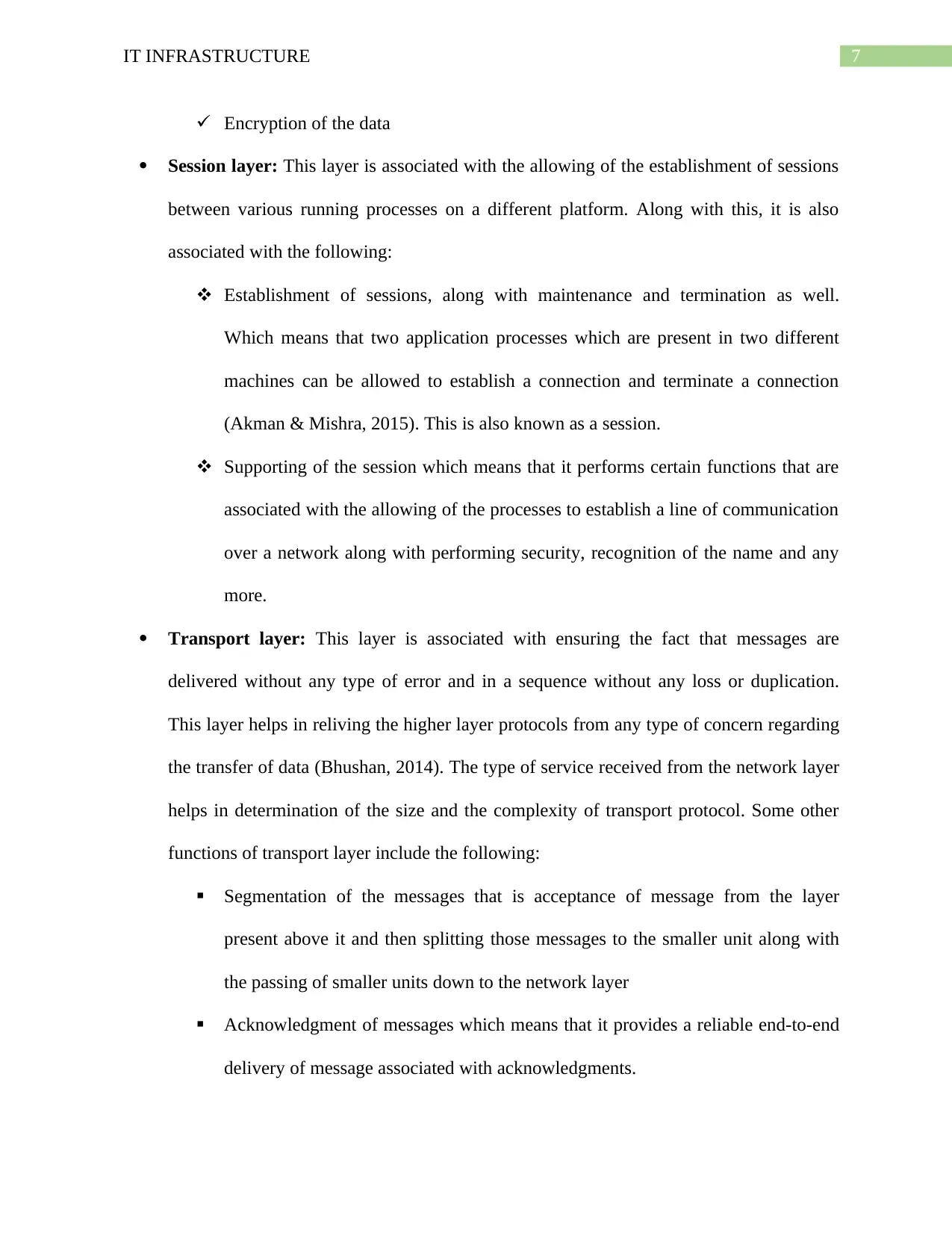
7IT INFRASTRUCTURE
Encryption of the data
Session layer: This layer is associated with the allowing of the establishment of sessions
between various running processes on a different platform. Along with this, it is also
associated with the following:
Establishment of sessions, along with maintenance and termination as well.
Which means that two application processes which are present in two different
machines can be allowed to establish a connection and terminate a connection
(Akman & Mishra, 2015). This is also known as a session.
Supporting of the session which means that it performs certain functions that are
associated with the allowing of the processes to establish a line of communication
over a network along with performing security, recognition of the name and any
more.
Transport layer: This layer is associated with ensuring the fact that messages are
delivered without any type of error and in a sequence without any loss or duplication.
This layer helps in reliving the higher layer protocols from any type of concern regarding
the transfer of data (Bhushan, 2014). The type of service received from the network layer
helps in determination of the size and the complexity of transport protocol. Some other
functions of transport layer include the following:
Segmentation of the messages that is acceptance of message from the layer
present above it and then splitting those messages to the smaller unit along with
the passing of smaller units down to the network layer
Acknowledgment of messages which means that it provides a reliable end-to-end
delivery of message associated with acknowledgments.
Encryption of the data
Session layer: This layer is associated with the allowing of the establishment of sessions
between various running processes on a different platform. Along with this, it is also
associated with the following:
Establishment of sessions, along with maintenance and termination as well.
Which means that two application processes which are present in two different
machines can be allowed to establish a connection and terminate a connection
(Akman & Mishra, 2015). This is also known as a session.
Supporting of the session which means that it performs certain functions that are
associated with the allowing of the processes to establish a line of communication
over a network along with performing security, recognition of the name and any
more.
Transport layer: This layer is associated with ensuring the fact that messages are
delivered without any type of error and in a sequence without any loss or duplication.
This layer helps in reliving the higher layer protocols from any type of concern regarding
the transfer of data (Bhushan, 2014). The type of service received from the network layer
helps in determination of the size and the complexity of transport protocol. Some other
functions of transport layer include the following:
Segmentation of the messages that is acceptance of message from the layer
present above it and then splitting those messages to the smaller unit along with
the passing of smaller units down to the network layer
Acknowledgment of messages which means that it provides a reliable end-to-end
delivery of message associated with acknowledgments.

8IT INFRASTRUCTURE
Controlling of the traffic present in the message which means asking the
transmitting station to back-off when there is no availability of the messaging
buffers.
Multiplexing of the Session which means “several message streams” or “sessions”
are multiplexed onto a single logical link. Along with this, a track of the messages
is kept so as to identify to which session the message belongs.
Network layer: this layer is associated with controlling of the operations of the subnet
along with decoding of the physical path that is to be taken which would be based upon
the conditions of the network, priority of the services and other factors as well. Some
other functions of this layer are listed below:
o Routing which means that it routes the frame among the networks.
o Controlling of the subnet traffic which means that the routers are associated with
instructing the sending station to throttle back the transmission of the frame
whenever the buffer of the router gets filled up (Craigie, Gillmore & Groshenny,
2012).
o Fragmentation of frame which means if the downstream of the routers maximum
transmission unit is determined to be less than the size of the frame then a router
would get fragmented into a frame for the transmission an then reassemble at the
destination station.
o Logical-physical address mapping which is associated with the translation into
physical address of the logical addresses or name.
o Keeping an account of the usage of the subnet, this means there is an accounting
feature which is capable of keeping track of the frames that are forwarded by the
Controlling of the traffic present in the message which means asking the
transmitting station to back-off when there is no availability of the messaging
buffers.
Multiplexing of the Session which means “several message streams” or “sessions”
are multiplexed onto a single logical link. Along with this, a track of the messages
is kept so as to identify to which session the message belongs.
Network layer: this layer is associated with controlling of the operations of the subnet
along with decoding of the physical path that is to be taken which would be based upon
the conditions of the network, priority of the services and other factors as well. Some
other functions of this layer are listed below:
o Routing which means that it routes the frame among the networks.
o Controlling of the subnet traffic which means that the routers are associated with
instructing the sending station to throttle back the transmission of the frame
whenever the buffer of the router gets filled up (Craigie, Gillmore & Groshenny,
2012).
o Fragmentation of frame which means if the downstream of the routers maximum
transmission unit is determined to be less than the size of the frame then a router
would get fragmented into a frame for the transmission an then reassemble at the
destination station.
o Logical-physical address mapping which is associated with the translation into
physical address of the logical addresses or name.
o Keeping an account of the usage of the subnet, this means there is an accounting
feature which is capable of keeping track of the frames that are forwarded by the
⊘ This is a preview!⊘
Do you want full access?
Subscribe today to unlock all pages.

Trusted by 1+ million students worldwide
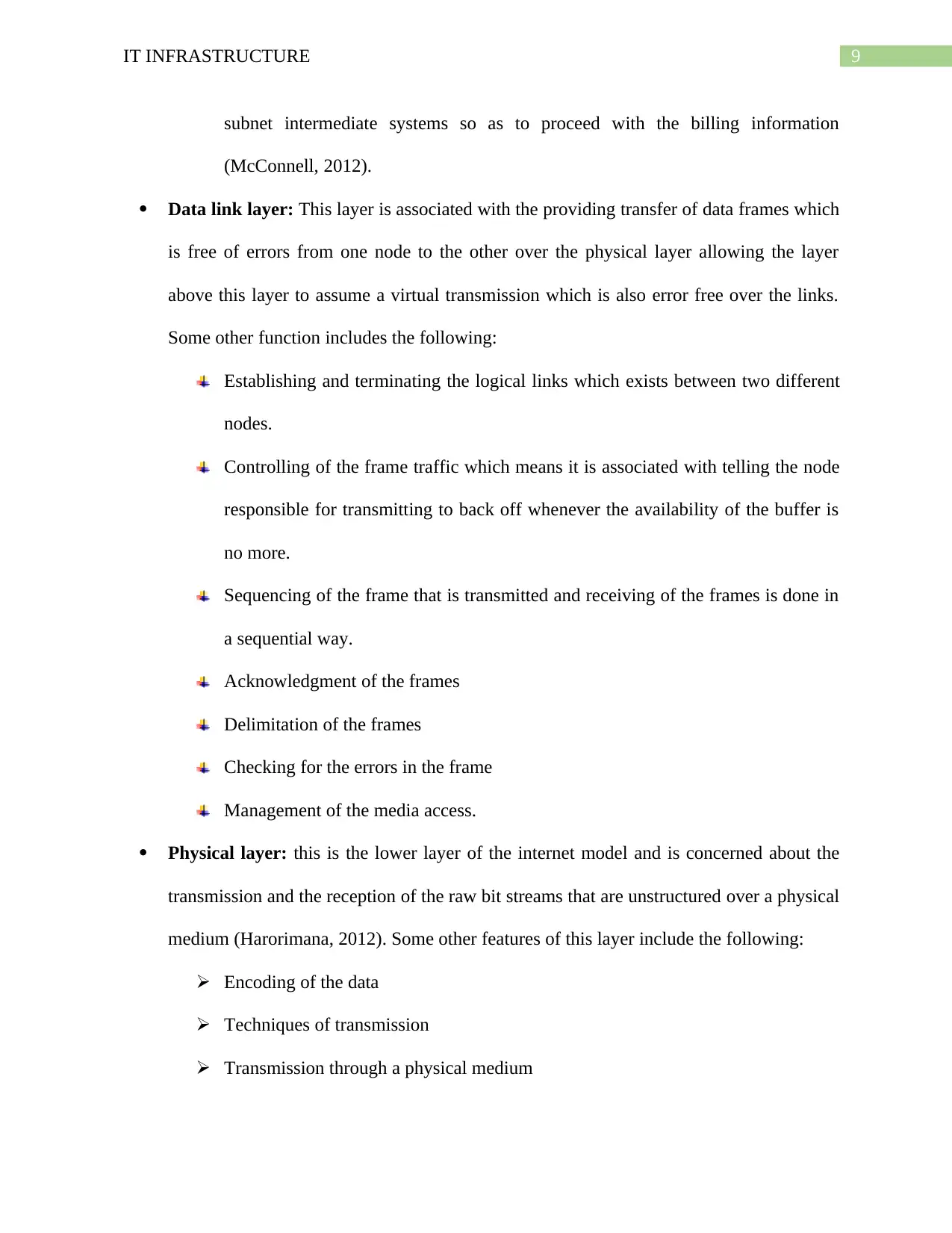
9IT INFRASTRUCTURE
subnet intermediate systems so as to proceed with the billing information
(McConnell, 2012).
Data link layer: This layer is associated with the providing transfer of data frames which
is free of errors from one node to the other over the physical layer allowing the layer
above this layer to assume a virtual transmission which is also error free over the links.
Some other function includes the following:
Establishing and terminating the logical links which exists between two different
nodes.
Controlling of the frame traffic which means it is associated with telling the node
responsible for transmitting to back off whenever the availability of the buffer is
no more.
Sequencing of the frame that is transmitted and receiving of the frames is done in
a sequential way.
Acknowledgment of the frames
Delimitation of the frames
Checking for the errors in the frame
Management of the media access.
Physical layer: this is the lower layer of the internet model and is concerned about the
transmission and the reception of the raw bit streams that are unstructured over a physical
medium (Harorimana, 2012). Some other features of this layer include the following:
Encoding of the data
Techniques of transmission
Transmission through a physical medium
subnet intermediate systems so as to proceed with the billing information
(McConnell, 2012).
Data link layer: This layer is associated with the providing transfer of data frames which
is free of errors from one node to the other over the physical layer allowing the layer
above this layer to assume a virtual transmission which is also error free over the links.
Some other function includes the following:
Establishing and terminating the logical links which exists between two different
nodes.
Controlling of the frame traffic which means it is associated with telling the node
responsible for transmitting to back off whenever the availability of the buffer is
no more.
Sequencing of the frame that is transmitted and receiving of the frames is done in
a sequential way.
Acknowledgment of the frames
Delimitation of the frames
Checking for the errors in the frame
Management of the media access.
Physical layer: this is the lower layer of the internet model and is concerned about the
transmission and the reception of the raw bit streams that are unstructured over a physical
medium (Harorimana, 2012). Some other features of this layer include the following:
Encoding of the data
Techniques of transmission
Transmission through a physical medium
Paraphrase This Document
Need a fresh take? Get an instant paraphrase of this document with our AI Paraphraser
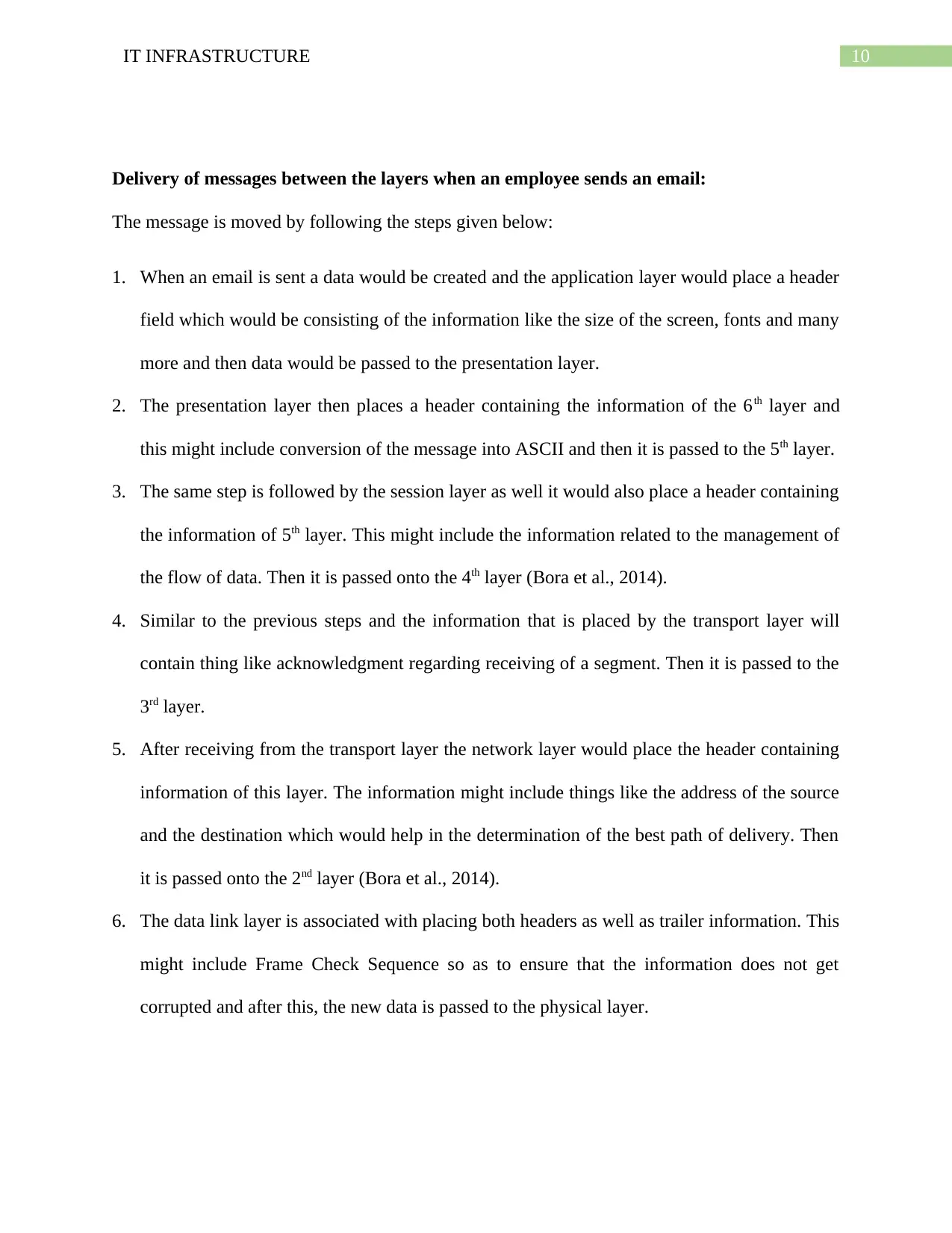
10IT INFRASTRUCTURE
Delivery of messages between the layers when an employee sends an email:
The message is moved by following the steps given below:
1. When an email is sent a data would be created and the application layer would place a header
field which would be consisting of the information like the size of the screen, fonts and many
more and then data would be passed to the presentation layer.
2. The presentation layer then places a header containing the information of the 6th layer and
this might include conversion of the message into ASCII and then it is passed to the 5th layer.
3. The same step is followed by the session layer as well it would also place a header containing
the information of 5th layer. This might include the information related to the management of
the flow of data. Then it is passed onto the 4th layer (Bora et al., 2014).
4. Similar to the previous steps and the information that is placed by the transport layer will
contain thing like acknowledgment regarding receiving of a segment. Then it is passed to the
3rd layer.
5. After receiving from the transport layer the network layer would place the header containing
information of this layer. The information might include things like the address of the source
and the destination which would help in the determination of the best path of delivery. Then
it is passed onto the 2nd layer (Bora et al., 2014).
6. The data link layer is associated with placing both headers as well as trailer information. This
might include Frame Check Sequence so as to ensure that the information does not get
corrupted and after this, the new data is passed to the physical layer.
Delivery of messages between the layers when an employee sends an email:
The message is moved by following the steps given below:
1. When an email is sent a data would be created and the application layer would place a header
field which would be consisting of the information like the size of the screen, fonts and many
more and then data would be passed to the presentation layer.
2. The presentation layer then places a header containing the information of the 6th layer and
this might include conversion of the message into ASCII and then it is passed to the 5th layer.
3. The same step is followed by the session layer as well it would also place a header containing
the information of 5th layer. This might include the information related to the management of
the flow of data. Then it is passed onto the 4th layer (Bora et al., 2014).
4. Similar to the previous steps and the information that is placed by the transport layer will
contain thing like acknowledgment regarding receiving of a segment. Then it is passed to the
3rd layer.
5. After receiving from the transport layer the network layer would place the header containing
information of this layer. The information might include things like the address of the source
and the destination which would help in the determination of the best path of delivery. Then
it is passed onto the 2nd layer (Bora et al., 2014).
6. The data link layer is associated with placing both headers as well as trailer information. This
might include Frame Check Sequence so as to ensure that the information does not get
corrupted and after this, the new data is passed to the physical layer.

11IT INFRASTRUCTURE
7. The bit stream is transmitted to be physical layer as ones or zeros. At this stage, the physical
layer ensures that bit synchronization is done which would ensure that the data that has been
transmitted from the end user is in the correct order in which it was sent.
Fig 2: Movement of messages between different layers of Internet
Kind of networks used at the organization
ANZ or Australia and New Zealand banking group makes use of the WAN or wide area
network. As this type of network would help in connecting different local area networks. This
helps in connecting different branches of bank together. WAN technology is used because it
helps the bank in carrying out its various operations regardless of the geographical location of
7. The bit stream is transmitted to be physical layer as ones or zeros. At this stage, the physical
layer ensures that bit synchronization is done which would ensure that the data that has been
transmitted from the end user is in the correct order in which it was sent.
Fig 2: Movement of messages between different layers of Internet
Kind of networks used at the organization
ANZ or Australia and New Zealand banking group makes use of the WAN or wide area
network. As this type of network would help in connecting different local area networks. This
helps in connecting different branches of bank together. WAN technology is used because it
helps the bank in carrying out its various operations regardless of the geographical location of
⊘ This is a preview!⊘
Do you want full access?
Subscribe today to unlock all pages.

Trusted by 1+ million students worldwide
1 out of 15
Related Documents
Your All-in-One AI-Powered Toolkit for Academic Success.
+13062052269
info@desklib.com
Available 24*7 on WhatsApp / Email
![[object Object]](/_next/static/media/star-bottom.7253800d.svg)
Unlock your academic potential
Copyright © 2020–2025 A2Z Services. All Rights Reserved. Developed and managed by ZUCOL.




